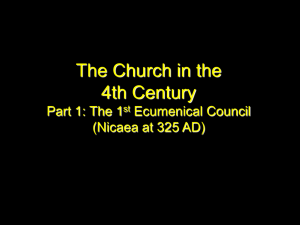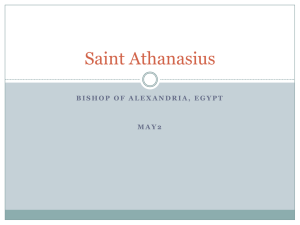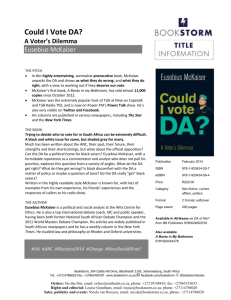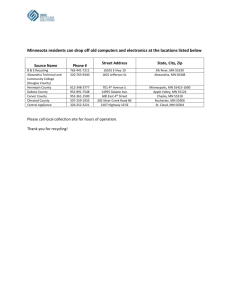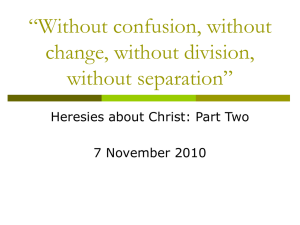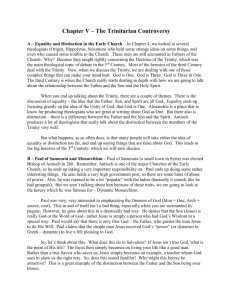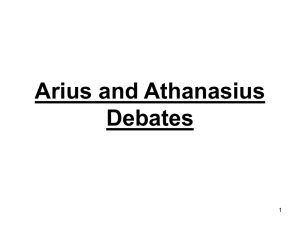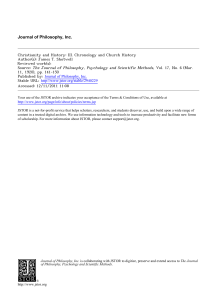File - Digital Ancient History
advertisement
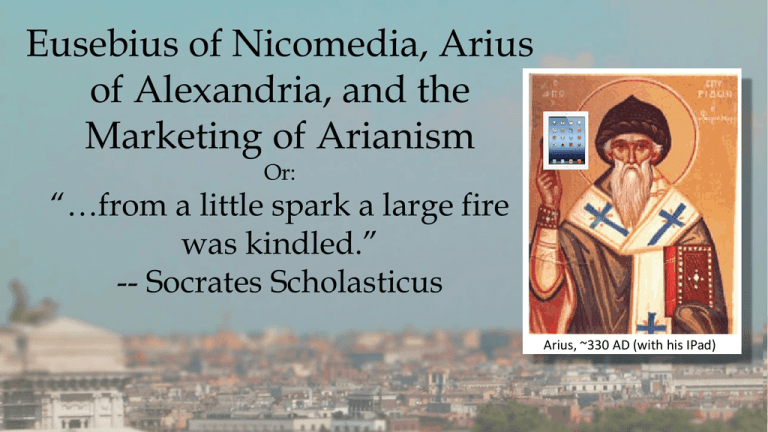
Eusebius of Nicomedia, Arius of Alexandria, and the Marketing of Arianism Or: “…from a little spark a large fire was kindled.” -- Socrates Scholasticus Arius, ~330 AD (with his IPad) Different Methods of Marketing Religious Beliefs in the 300s: Letter/Tract Writing Use of Scripture Persecution of Rivals Songs/Ditties Eusebius of Nicomedia and Arius (Beautiful Buildings/Artwork) Public Debates The Top-Down Method Church Councils Background to Arianism: “Arians”: • Arius—a priest • Bishop Eusebius of Nicomedia • Bishop Eusebius of Caesarea Nicomedia “Nicenes”: • Bishop Alexander of Alexandria • Bishop Athanasius • Emperor Constantine (sometimes) • Eusebius of Caesarea (sometimes) Constantinople Caesarea Alexandria Arian Christianity The Father is eternal; The Son is emanated from or created by the Father (and therefore comes later) “There was a time when the Son was not” Nicene (later Catholic) Christianity The Father, Son, and Holy Spirit are Eternal (homoousius==same nature) Christianity is supposed to be Monotheistic (One God) • The Nicenes solved this by believing that the Trinity (Father, Son, and Holy Spirit) is one nature, but has different roles • The Arians solved this by having God eternal Letter Writing (most were designed to be public) Admonitions Bishops to fellow bishops Letters to parishioners Demands And Emperors to Bishops Requests Bishops to Emperors Textual Analysis Topic Modeling—using computational linguistics to search for clusters of words Computational Historiography or Algorithmic Historiography David Mimno “Computational Historiography: Data Mining in a Century of Classics Journals,”5, 1, Article 3 (April 2012), 19 pages. Journal on Computing and Cultural Heritage (http://www.perseus.tufts.edu/~amahoney/02-jocchmimno.pdf ) Bottom up: the program looks for clusters of words in a text The Top-Down method—you give it the keywords Textisbeautiful.net Wordle.net (just shows frequency of words) The Stanford Natural Language Processing Group (useful for extremely large volumes of text) MALLETT : MAchine Learning for LanguagE Toolkit (useful for extremely large volumes of text) Show word maps and association maps Text is Beautiful The Deposition of Arius, by Bishop Alexander Of Alexandria (319 AD) “Concept Cloud” Shows Frequency of use represented by the size of the text. The Color shows groups The Deposition of Arius, by Bishop Alexander Of Alexandria (319 AD) “Concept Web” Concepts will be positioned closely to other concepts that they are highly related to. The Deposition of Arius, by Bishop Alexander Of Alexandria (319 AD) “Correlation Wheel” Shows prominent relationships between concepts with high prominence scores. “Almost always together, rarely apart” Not related to frequency The Deposition of Arius, by Bishop Alexander Of Alexandria (319 AD) “Correlation Wheel” Shows prominent relationships between draws links between concepts with high prominence scores “Almost always together, rarely apart” Not related to frequency O.k.—so what? Can reveal new relationships of ideas/concepts/words within a text --very useful for large texts (up to 25,000 words, or 100 pages for textisbeautiful—much, much more for other programs) Better than keyword searches Example from Early American Studies: “Doing More with Digitization: An introduction to topic modeling of early American sources” by Sharon Block, www.common-place.org · vol. 6 · no. 2 · January 2006 Use of Letter Metadata a letter’s date, author, recipient, point of origin, point of reception to create spatial analysis of intellectual correspondence networks. Alexander of Alexandria’s letters Eusebius of Nicomedia’s letters Letters of Emperor Constantine Letters of Athanasius of Alexandria Letters of Julius, Bishop of Rome Use of Scripture: The Arian use of the Bible “There was a time when the Son was not” ***Proverbs 8:22-5: “The Lord created me at the beginning of His ways…before the ages he founded me…before all the hills he begets me.” Matt. 4:2 (cf. Luke 4:2) “Then Jesus was led up by the Spirit into the wilderness to be tempted by the devil. 4:2 He fasted forty days and forty nights, and afterwards he was famished.” Jn 8:42 Jesus said to them, "If God were your Father, you would love me, for I came from God and now am here. I have not come on my own; but he sent me.” Nicene/Catholic use of the Bible Psalms 110:3 From the womb, before the morning have I begotten you? John 1:1 In the beginning was the Word John 1:18 …the only-begotten Son John 1:3 …by Him were all things made John 14:9 He who has seen Me has seen the Father? John 14:10 I am in the Father, and the Father in Me John 10:30 My Father and I are one Public Debates Arius was known to publically debate (Theoderet, H.E. 1.1, 1.2) Auxentius, an Arian bishop living in Milan, Italy (in the 380s) In the late 300s there are a large number (both Arian and otherwise) The Top-Down Method The conversion of the Emperor/other bishops/local hierarchy See Philostorgius 3.12: Athanasius and the Homoousian (Nicene) faith Constantina Emperor Constantius II 341(?) Eusebius, bishop of Nicomedia becomes bishop of Constantinople, the most powerful see in the east Church Councils 318-320—Church Council in Alexandria, Egypt: Arius was kicked out of the church 320-322 Eusebius of Caesarea and Eusebius of Nicomedia held a council and said that Arius was Orthodox 325 (early) Church Council at Antioch: Eusebius of Caesarea was threatened with excommunication 325 Council of Nicea 335 Council of Tyre (condemnation of Athanasius) 343 Council of Sardica 358 Council of Sirmium 359 Council of Rimini 359 Seleucia (16 different creeds during this period alone) Persecution of Rivals “Heretics” and Exile • Arius • Eusebius of Nicomedia and Theognis of Nicea • Athanasius, Bishop of Alexandria, was sent into exile five times between 328-373 Persecution of Rivals Charges: Killings, charges of disrupting church services/destroying church paraphernalia, kidnappings, disrupting the official food supply to Constantinople , sexual exploits (mistresses, having children with prostitutes), confusing innocent virgins Death of Arius in 336 (Socrates Scholasticus H.E. 1.38) Songs/Jingles Philostorgius H.E. 2:2: Sailors, millers, travellers “King Henry the Eighth, to six wives he was wedded. One died, one survived, two divorced, two beheaded.” “Thalia” (The Banquet)—by Arius We Just Can’t Get Along… We are never, ever, ever, getting back together We are never, ever, ever, getting back together You go talk to your friends, talk to my friends, talk to me But we are never, ever, ever, ever, getting back together --Taylor Swift (Or Athanasius talking to Arius/Eusebius) Use of Churches Arian Baptistery Ravenna, Italy Ambrose vs. Emperor Valentinian II and his wife Justina (in the 380s) A Walk-Through of St. Peter’s Basilica Open up your 360Cities App Search (the search-glass is in the upper left) for St. Peters Basilica Along the top there is a Map button or a List button. Click on List. Open up the one titled: 2011 05 18 13 54 Vatican St Peter High Resolution Did all of these techniques matter, and/or did they make an impression on the common people? • • • • • • Individuals fought each other Cities were divided Religious riots Churches were burned or invaded by the other side Official Persecution Natural Disasters (believed to be brought on by God) Keeping Up with the (Ancient) Times using Modern Tech: • • • • • • ***Scoop.it (http://www.scoop.it/t/Arianism) Google Scholar (which will email new scholarship to you) Twitter (hardly anything on Arianism that is academic) Blogs (not very many!) Podcasts JSTOR Presentation of Research: • ThingLink/Aurasma/My personal website www.digitalancienthistory.com ; Slideshare; Future Research Directions • Rise of Christianity: History, Documents, and Key Questions (manuscript is due May 1, 2015). I’ll be using these categories (along with digital material— podcasts, videos, timelines, using Aurasma) • A book on Eusebius and the part he played in spreading Arianism • Digital mapping projects (using GIS—Geographical Information System): The spread of both Christianity and the “Barbarians” and incorporating this research on why and how they converted Different Methods of Spreading/Accepting Religious Beliefs: Letter Writing Use of Scripture Persecution of Rivals Songs/Ditties ***Eusebius of Nicomedia and Arius (Beautiful Buildings/Artwork) Public Debates The Top-Down Method Church Councils Appeal of Manichaeism • • • • Intellectual appeal Duality Art Appeal to women Concept Cloud History of the Arians-Athanasius Concept Web Early 300s AD Ulfila the Goth Ossius of Cordova Alexander of Alexandria George of Constantinople Eusebius of Nicomedia and Arius Emperor Constantine Athanasius of Alexandria Eusebius of Caesarea Emperor Constantius II Emperor Licinius Use of Art The Baptism of Constantine by Pope Sylvester ----Raphael or Penni (1520s) Sylvester died in 335 Constantine died in 337 “Donation of Constantine” (torn apart by L. Valla) A mosaic in the Arian Baptistery, Ravenna, Italy (about 500 AD) Early Christianity databases • Thesaurus Linguae Graecae: A digital library of Greek works • The Unbound Bible • All-in-One Biblical Resources Search • American Theological Library Association religion database • Windows contains a very simple data search that will look for specific words within a folder
